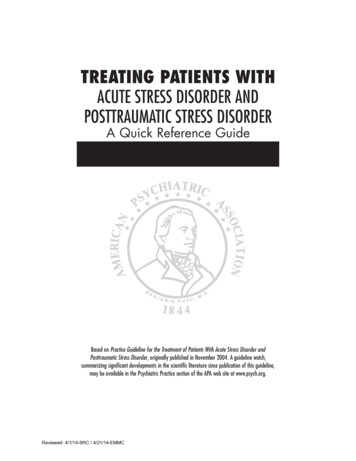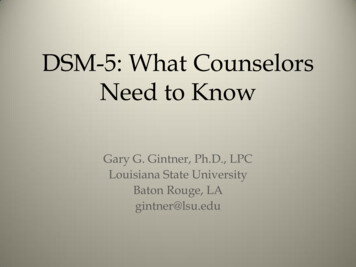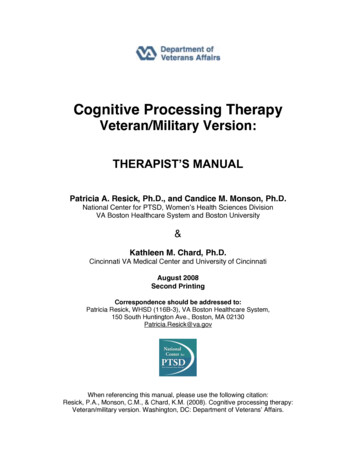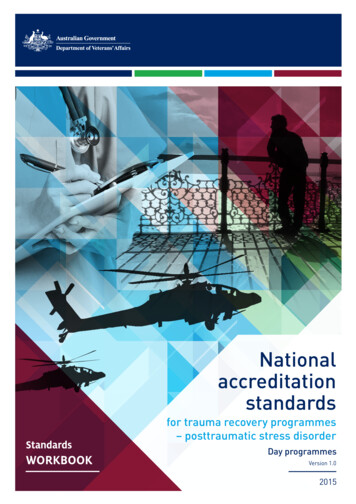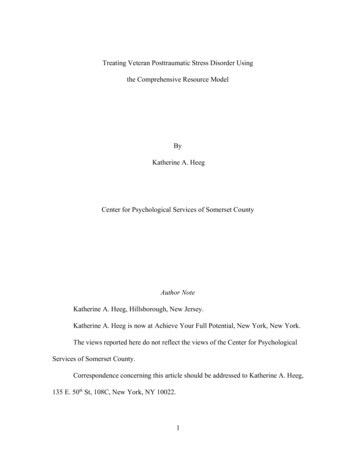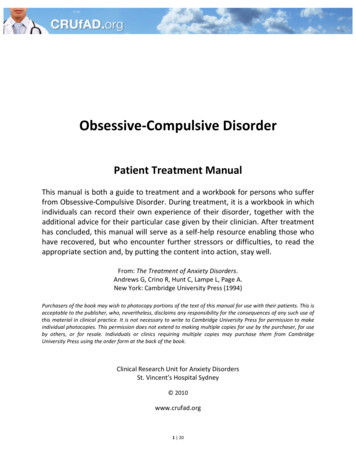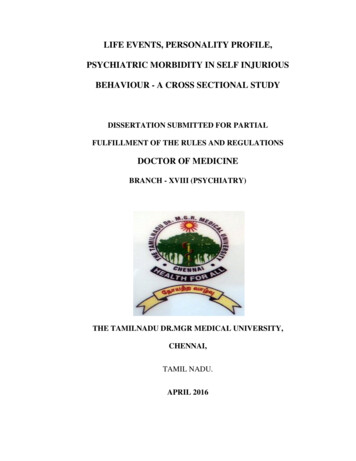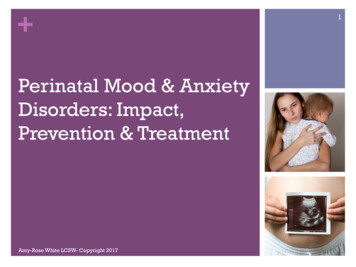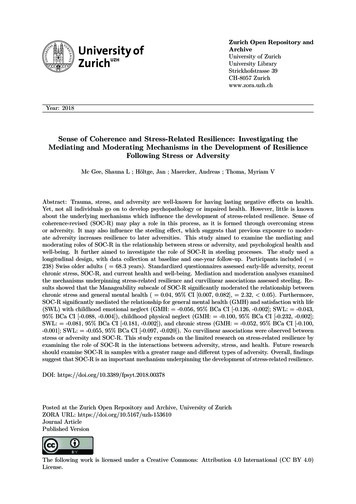
Transcription
Posttraumatic Stress DisorderPatient Treatment ManualThis manual is both a guide to treatment and a workbook for persons whosuffer from Posttraumatic Stress Disorder. During treatment, it is a workbookin which individuals can record their own experience of their disorder, togetherwith the additional advice for their particular case given by their clinician. Aftertreatment has concluded, this manual will serve as a self‐help resourceenabling those who have recovered, but who encounter further stressors ordifficulties, to read the appropriate section and, by putting the content intoaction, stay well.From: The Treatment of Anxiety Disorders.Andrews G, Crino R, Hunt C, Lampe L, Page A.New York: Cambridge University Press (1994)Purchasers of the book may wish to photocopy portions of the text of this manual for use with their patients.This is acceptable to the publisher, who, nevertheless, disclaims any responsibility for the consequences of anysuch use of this material in clinical practice. It is not necessary to write to Cambridge University Press forpermission to make individual photocopies. This permission does not extend to making multiple copies for useby the purchaser, for use by others, or for resale. Individuals or clinics requiring multiple copies may purchasethem from Cambridge University Press using the order form at the back of the book.Clinical Research Unit for Anxiety DisordersSt. Vincent’s Hospital Sydney 2010www.crufad.org1 54
Section 1IntroductionExperience of a traumatic event can shatter a person's life, leaving them feeling vulnerableand frightened. It is very important to remember that recovery is possible and that you can lead anormal, happy life again. This does not mean that you will forget what happened to you or that youwill never again be distressed by memories and reminders of the event. A certain amount of distresswhen you think about what happened is part of being a normal, caring human being and we certainlydo not want you to have no feelings. However, the distress will become less frequent and moremanageable ‐ it will no longer control your life as it may do now. Recovery also does not mean thatyou will be exactly the same person that you were before the trauma. Such powerful experiencesmay change people in many ways, not all of them negative. As people recover from trauma, they mayfind themselves stronger than before, perhaps more caring and with a more balanced and sensibleview about what is important in their lives.By seeking some help, you have taken the first steps to recovery. The purpose of this manualis to help you through the treatment process in a step by step fashion. There is a great deal ofinformation here ‐ take it slowly and read each section as often as necessary until you understand itbefore moving on. You will be asked to write things down from time to time, so we suggest that youfind an exercise book to use for those tasks that you will keep adding to throughout your recovery.Try not to worry if it all seems too difficult at the moment ‐ recovery from trauma is often a longprocess and you need to take things one day at a time, recognising small improvements as theyoccur. It can be a long journey, but it will be worth it.2 54
1. The Nature of Traumatic Stress and PTSDAt some point in our lives, nearly all of us will experience a very frightening or distressingevent that will challenge our view of the world or ourselves. Virtually everyone develops some kindpsychological reaction following such experiences ‐ this is part of a normal human response toextreme stress. Most people will recover over the weeks and months following the incident with thehelp of caring family members and friends. For some, however, recovery does not come so easily andmore serious problems develop. In those cases, professional help is often required.Some individuals who experience a traumatic event will go on to develop a chronic conditionknown as Posttraumatic Stress Disorder (PTSD). The exact numbers are difficult to specify, butanywhere between 5% and 40% of trauma survivors may develop PTSD. The question of why somepeople are affected more than others has no simple answer ‐ many factors are involved. It seems tobe a complex mix of what the person was like before the trauma, their experience of otherfrightening events in the past, the severity of the current trauma, and what else is happening in theirlives as they try to recover. Regardless of the causes, effective treatment does a great deal to improvethe chances of recovery.1.1 What Is a Traumatic Event?Trauma is a very personal thing. What traumatises one person can be of less significance toothers. This variation in peoples' reactions occurs because of their individual personality, beliefs,personal values, and previous experiences (especially of other traumatic events in their life). It occursalso because each person's experience of the incident is unique. However, in all cases the individualhas experienced a threatening event that has caused them to respond with intense fear,helplessness, or horror. The threat or injury may be to themselves or to others close to them. Typical3 54
traumatic events may be of human origin (such as war experiences, physical assault, sexual assault,accidents, and witnessing the death or injury of others) or of natural origin (such as bushfires,earthquakes, floods, and hurricanes). Overall, there are no hard and fast rules to define trauma.1.2 What is PTSD?PTSD is a psychological response to the experience of intense traumatic events, particularlythose that threaten life. It can affect people of any age, culture or gender. Although we have startedto hear a lot more about it in recent years, the condition has been known to exist at least since thetimes of ancient Greece (more than 2000 years ago) and has been called by many different names. Inthe American Civil War it was referred to as “soldier’s heart”, in World War I it was called “shellshock”, while by World War II it was known as “war neurosis”. In civilian life, terms such as "shockneurosis", "railway spine", and "rape trauma syndrome" were used in the past.Traumatic stress can be seen as part of a normal human response to intense experiences.While most people recover over the first few months, for many the symptoms do not seem to resolvequickly and, in some cases, may continue to cause problems for the rest of the person's life. It is alsocommon for symptoms to vary in intensity over time. Some people go for long periods without anysignificant problems, only to relapse when they have to deal with other major life stress. In rare cases,the symptoms may not appear for months, or even years, after the trauma.1.3 Common Symptoms of PTSDPTSD is characterised by three main groups of problems. They can be classified under theheadings of intrusive, avoidant and arousal symptoms:1.3.1 Intrusive SymptomsMemories, images, smells, sounds, and feelings of the traumatic event can “intrude” into thelives of individuals with PTSD. Sufferers may remain so captured by the memory of past horror that4 54
they have difficulty paying attention to the present. People with PTSD report frequent, distressingmemories of the event that they wish they did not have. They may have nightmares of the event orother frightening themes. Movement, excessive sweating, and sometimes even acting out the dreamwhile still asleep may accompany these nightmares. They sometimes feel as though the events werehappening again; this is referred to as “flashbacks”, or “reliving” the event. They may becomedistressed, or experience physical signs such as sweating, heart racing, and muscle tension, whenthings happen which remind them of the incident. Overall, these “intrusive” symptoms cause intensedistress and can result in other emotions such as grief, guilt, fear or anger.Intrusive Symptoms of PTSD: Distressing memories or images of the incident Nightmares of the event or other frightening themes Flashbacks (reliving the event) Becoming upset when reminded of the incident Physical symptoms, such as sweating, heart racing, or muscle tension when reminded of theevent1.3.2 Avoidance SymptomsMemories and reminders of traumatic events are very unpleasant, causing considerabledistress. Therefore, people with PTSD often avoid situations, people, or events that remind may themof the trauma. They try not to think about, or talk about, what happened, and attempt to cutthemselves off from the painful feelings associated with the memories. In their attempts to do this,they often withdraw from family, friends, and society in general. They begin to do less and less, nolonger taking part in activities they used to enjoy. This may help them to shut out the painfulmemories, but it can also lead to feelings of isolation and of not belonging to the rest of society. In5 54
this way the person can become “numb” to their surroundings and not experience normal everydayemotions such as love and joy, even towards those close to them. Such reactions can lead todepression and problems within the family. They can also lead to severe problems with motivation ‐people with PTSD often find it hard to make decisions and to get themselves going. They may havedifficulty making the effort to help themselves or even to do things that they would previously havefound enjoyable or easy. This can be very hard for family and friends, who often think that thesufferer is just being lazy or difficult.Avoidance and Numbing Symptoms of PTSD: Trying to avoid any reminders of the trauma, such as thoughts, feelings, conversations,activities, places and people Gaps in memory ‐ forgetting parts of the experience Losing interest in normal activities Feeling cut‐off or detached from loved ones Feeling flat or numb Difficulty imagining a future1.3.3 Arousal SymptomsPeople who have experienced a trauma have been confronted with their own mortality. Theirassumptions and beliefs that the world is safe and fair, that other people are basically good, and that"it won't happen to me", have been shattered by the experience. After the event, they see dangereverywhere and become “tuned in” to threat. As a consequence, they may become jumpy, on edge,and feel constantly on guard. This can lead to being overly alert or watchful and to having problemsconcentrating (for example, not able to read a book for long, getting only a small amount of workcompleted in a few hours, easily distracted). It is common for sleep to be very disturbed ‐ difficulty6 54
getting off, restlessness through the night, or waking early. Sometimes people find that they arefrightened to go to sleep because of the nightmares or because they feel unsafe.Anger is often a central feature in PTSD, with sufferers feeling irritable and prone to angryoutbursts with themselves, others around them, and the world in general. In part, the anger is oneway of expressing the feelings of being tense and on‐edge that are associated with PTSD ‐ for somepeople it is easier to acknowledge anger than fear. In addition, however, this anger results from thefeelings of injustice caused by the trauma ‐ a reaction to the gross unfairness of it all. Anger andirritability frequently causes major problems at work, as well as with family and friends.Arousal Symptoms of PTSD: Sleep disturbance Anger and irritability Concentration problems Constantly on the look‐out for signs of danger Jumpy, easily startled1.4 Associated ProblemsPTSD is not the only psychological response to trauma. People may develop a range of otherproblems that can affect their quality of life, their ability to relate to other people, and their capacityfor work. These problems may occur on their own, or as part of the PTSD. Many of these problemsare thought to be the result of people trying to control either themselves and their symptoms (suchas alcohol and drug abuse) or their environment (such as avoidance behaviour and angry outbursts).Also, many of the signs are directly related to stress (such as skin complaints and general aches andpains). Overall, the most commonly associated problems in PTSD are those relating to anxiety,depression, and alcohol or drug use ‐ we will discuss each of these briefly. They can be very disabling7 54
to the sufferer, and may affect family members and work colleagues. Many of the following problemsdevelop over time as the person struggles to cope with the PTSD. If you are in the early stagesfollowing a trauma, some of the following may not apply to you.Anxiety: Anxiety is a state of apprehension and worry that something unpleasant is about tohappen. It is often accompanied by a range of physical symptoms (such as sweating, heart racing, andbreathing difficulties) which are, in themselves, very frightening. Sometimes people experiencingthese symptoms believe that they are going to die from a heart attack or go crazy. Anxiety can bespecific to certain situations (such as social events, crowded places, or public transport), or it can be ageneral state of worry about many things in our lives. If you are having significant problems in theseareas, be sure to tell your therapist. Treatment (as outlined in other chapters in this book) can be veryeffective.Depression: Depression is a general state of low mood and a loss of interest or pleasure inactivities that were once enjoyed. Life becomes flat and grey, and nothing seems fun, exciting, orenjoyable anymore. These depressed states can be very intense, leading to a total withdrawal fromothers and a state of numbness, or they can be lower in intensity ‐ just feeling "down in the dumps".They may last for as little as a few hours or as long as months or even years. In more severe cases, theperson may believe that life is no longer worth living. Many people who suffer from PTSD over a longperiod develop significant problems with depression. Again, it is important to tell your therapist ifthese problems apply to you. It can be treated effectively with psychological treatments and/orprescription drugs.Guilt: People with PTSD often report strong feelings of guilt, shame, and remorse. This may beabout the fact that they survived while others did not; it may be about what they had to do tosurvive; it may be related to how they have coped or acted since the trauma. Guilt is often the mostdifficult thing to talk about, especially if you feel that you did something wrong or acted in a bad way.8 54
However, it is very important that you work on those feelings as part of your PTSD treatment so besure to tell your therapist about those feelings.Alcohol and Drugs: In an attempt to cope with the unpleasant symptoms, many people turnto alcohol or other drugs. Although they may seem to help in the short term, they prevent the personfrom recovering effectively and lead to long term problems. Drug and alcohol abuse impairs theperson's ability to function effectively and to relate to other people. It can cause great difficulties inareas such as relationships, work, finances, and violent behaviour.Impact on Relationships and Work: Traumatised people can become "consumed" by theirfeelings, which may lead others to believe that they are selfish, thinking only of themselves. Difficultyfeeling and expressing emotions (for example, love and enthusiasm), loss of interest in sex, andreduced participation in activities and hobbies that they used to enjoy before the trauma arecommon. Traumatised people are often tired and can become cranky and irritable. They may sayhurtful things without really considering the implications of what they are saying. All of thesesymptoms may cause partners to feel rejected and unloved, and the absence of shared enjoyableactivities makes it difficult to have a normal family life. It is very important to keep communicatingabout what is happening ‐ try to be reasonably honest with each other about how you are feeling.People with PTSD may have difficulty coping with pressure at work. Irritability, jumpiness,mood swings, poor concentration, and memory problems may lead to disputes in the workplace andfrequent job changes. Some people with PTSD adopt a workaholic pattern, shutting themselves awayin their work and putting in very long hours. This seems to be part of the avoidance component ofPTSD ‐ keeping very busy helps to prevent the memories and unpleasant thoughts coming back ‐ butit does not help in the long term. Others find that their problems prohibit them from workingeffectively at all.9 54
1.5 Why Do Traumatic Stress Reactions Develop?It is important to understand where the signs and symptoms of PTSD come from. One of theleading clinicians in the area, Mardi Horowitz, described trauma as an experience that is, by its verynature, overwhelming. It contains lots of new information that is hard to accept or understand. Itdoes not fit with our view of the world or ourselves ‐ the way we think things are or should be.Human beings have a natural tendency to try and make sense of things that happen around them.When people experience a trauma, the event keeps coming back into their mind in an attempt tomake sense of what happened. This is the body's natural way of trying to deal with, or come to termswith, difficult experiences and seems to work well for many stressful life events. However, due to thehigh level of distress associated with memories of more severe trauma, the thoughts and feelingstend to be pushed away to protect the person from this distress. The result is that, whilst the memorymay go away for a while, the need for it to be dealt with has not been addressed and it keeps comingback. The movement backward and forward from intrusive thoughts and feelings about the traumato avoidance and numbing can then continue almost indefinitely unless the cycle is addressed insome way.Throughout this alternating between short bursts of painful memories and periods ofavoidance and numbing, the sense of feeling keyed‐up persists. The traumatised person has beenthrough an event that threatened their life, or the life of someone else, so the mind and body stay onalert to make sure that no future potential dangers will be missed. It is safer to get it wrong byoverestimating potential threat than to risk the possibility of missing any future threat. The persistentactivation of this threat detection system, however, leaves the traumatised person feeling keyed‐upor on edge much of the time. In addition, the threat detection system is so sensitive that it isconstantly going off when there is no danger in such a way that interferes with the person’s capacityto live a normal and happy life.10 54
Traumatic stress reactions, therefore, are sensible and adaptive both as part of survival duringthe trauma and in attempts to come to terms with the trauma afterward. Once we recognise wherethese symptoms come from, it is easier to understand the typical traumatic stress reactions. Thedifficult part is letting go of these reactions now that they have ceased to provide benefit and areinterfering with the traumatised person’s quality of life.1.6 The Process of Treatment And RecoveryYou have already started the first stage of recovery by acknowledging your reactions to thetraumatic event. Presumably, you have also taken the next step of seeking appropriate treatmentfrom a mental health professional. Getting help is often frightening ‐ for many, it is a leap into theunknown ‐ but trying to recover from PTSD on your own is much more difficult. Treatment usuallyinvolves several stages; we will go through each of these in turn.PTSD: Stages of treatment:1. Crisis stablisation and engagement2. Education about PTSD and related conditions3. Strategies to manage the symptoms4. Trauma focussed therapy (confronting the painfulmemories and feared situations)5. Cognitive restructuring (learning to think morerealistically about what happened)6. Relapse prevention and on‐going supportIt is important to remember that treatment can be painful and hard work. Unfortunately,there is no easy way to get rid of the memories or make them less distressing. There is no magic11 54
wand that your therapist can wave or tablet that you can take to make it all go away. But the long‐term gains can be enormous: effective treatment can dramatically assist your recovery, helping youto live a normal life once again.12 54
Section 22. Stabilisation of a Crisis and Engagement in TreatmentPeople who have been through a trauma often have other difficult situations to deal with inthe aftermath. These may be legal issues, family disruptions, financial problems, or a multitude ofother crises. It is important that any current life crises are resolved, or at least put "on hold", beforethe real treatment of PTSD can begin. It is not possible to devote the necessary concentration, time,and energy to your recovery if you are constantly worried about your job, your relationship, yourchildren, or other important life areas. That is not to say that you have to be able to solve all thoseproblems before you can work on your PTSD, but you will need to be able to put them to one side fora while to concentrate on your treatment. Therapy is hard work ‐ there is no easy way to do it ‐ andyou will need to devote all your personal resources to the task. If other life issues are worrying you, itis important that you discuss these with your therapist as they arise so that they do not interfere toomuch with your treatment.The first part of treatment will often be devoted to developing a relationship with thetherapist (or the treatment team if you are taking part in a group program). You will need to spendsome time getting to know each other, and building trust, if you are to work on the difficult issues.We call this process "engagement". For many people with PTSD, this is a very difficult process ‐experience of a traumatic event often makes it very hard to trust another person, particularlysomeone who you have never met before. In many cases, you will need to tell your therapist aboutexperiences and feelings that you have never discussed with anyone. We need to recognise that thisis a difficult process that will take a lot of courage, but it will be worth it and it is the only way torecovery.13 54
Section 33. Education and InformationPTSD can sometimes feel like an incomprehensible cloud that hangs over all areas of theperson's life. The first step in treatment is to understand exactly what trauma is, why we have thesymptoms we do and, therefore, why it is treated the way it is. In this regard, you have come a longway already by reading the sections above. You need to know what the common signs and symptomsare, and you need to recognise that you are not alone ‐ many people who have experiencedtraumatic events have responded in exactly the same way as you have. You need to understand whythe symptoms have appeared ‐ the fact that they were very useful for survival while the traumaticevents were happening but that they are no longer useful. They have become "maladaptive" and nowonly serve to create problems and distress for you. You need to understand what treatment willinvolve and how it may affect you. It is very important that you feel able to ask your therapistquestions about the nature of your problems and the process of treatment. He or she will not have allthe answers, but together you will reach a better understanding of what has happened and how youwill recover.Sometimes, people who have been through a traumatic event have trouble understandingwhat happened and why it happened. You may find yourself constantly asking questions such as"how did this happen" or "why me?" This is partly because, when we are under threat, our attentionis very focussed on the source of the danger and we do not take in all the other things that arehappening around us. We may end up with a distorted and confused memory of the experience, sothat it becomes difficult to understand and make sense of the event. This confusion often stops usfrom being able to put the experience behind us. For this reason, your therapist may help you to findout more about what happened during the event. This process is important in being able to "put thepieces of the jigsaw puzzle together" and make sense of your experience. A good understanding of14 54
exactly what happened, and why it happened, often facilitates recovery.Although we have put this under the heading of "Education and Information", it is actuallysomething that may happen at several stages throughout treatment and you need to make sure thatyou are ready before you pursue these options. When you are feeling reasonably confident, however,ask yourself what other information you need to help you understand what happened and why ithappened: Is there anyone else you can talk to who may be able to clarify things for you and help youreach a better understanding of your experience (such as others who were there, policeofficers, or ambulance officers)? Is there anything you can read that will help to fill in the missing pieces (such as mediareports, police statements, or reports from a trial or Coroner's Inquest)? Sometimes,reading accounts written by other survivors of trauma can be useful in understanding yourreactions. Occasionally there may even be video footage available from news reports or othersources: Is there anything you can watch that will help you fill in the gaps?Unfortunately, of course, it is not always possible to fill in all the gaps in your understanding ofthe event. Sometimes we may never find out exactly what happened (or, more commonly, why ithappened) and treatment needs to focus on helping us learn to live with that uncertainty.15 54
Section 44. Managing Anxiety and DistressThe next step is to help you feel more in control of your reactions. We will do this in severalparts. First, there are many simple things you can do in your day to day life that will make you feelmore in control and less distressed. There is nothing magical about these "Hints For Coping" ‐ mostare simply common sense ‐ but they can make a real difference. The second part involves morespecific strategies that your therapist will teach you to control your anxiety and distress. Some ofthese are useful in lowering your overall level of tension and stress ‐ the more relaxed you are ingeneral, the better you will cope when the memories return or you are confronted with otherunexpected difficulties. Everyone experiences increases in anxiety and distress at those times. If youroverall level of stress is high, these escalations will take you up into the level of high anxiety and panic(the top line in Figure 1). If your overall level is lower, the shape will be the same ‐ you will still reactto negative events ‐ but your anxiety and distress will not reach the same heights (the lower line inFigure 1). We will call these "routine strategies" since we want them to become part of your everydayroutine. Examples would be regular exercise, rest, sensible diet, and relaxation (see below). Otherstrategies are designed to help you deal more specifically with difficult situations when you can feelyour anxiety escalating and you are beginning to feel overwhelmed. These require a lot of practice,but are very useful to use when the feelings of distress and anxiety are particularly strong.16 54
Quick strategies tomanage escalationsAnxietyHigh anxiety& panicRoutine strategies tolower overall levelsTimeFigure 1: Reducing your general level of tension and managing escalations in anxiety4.1 Hints For CopingThe following is a list of tips that many people find useful. Do not try to do everything at once.When you have read the following sections, you may wish to stop for a while and work out a "plan ofaction". Which strategies sound particularly useful for you? Which ones are you prepared to try? Wesuggest that you select only one or two to begin with. Work out a plan to achieve them, one at atime, and set yourself some realistic goals for the next week. At the end of the week, review yourprogress: modify your goals if necessary and/or try some additional strategies for the following week.Over time, you will gradually develop a range of coping strategies and changes to your lifestyle that17 54
will help you to feel more in control of your symptoms and get more out of life. Eat healthy meals. This sounds so simple, but how many of us actually do it? A poor diet(especially junk food with lots of sugar) will increase your stress levels ‐ if in doubt, talk toyour general practitioner or a dietician. Get regular aerobic exercise like walking, jogging, swimming, or cycling. Exercise is veryeffective in managing stress. If you have PTSD, your body is constantly geared up for "fightor flight". Exercise helps to burn up those chemicals (like adrenalin) that are hyping you upand it will help you to become more relaxed. Get enough rest, even if you can't sleep. Rest will help to increase your reserves ofstrength and energy. (See also the section below on "Sleeping Better"). Establish, and try to stick to, daily routines (e.g., go to bed and get up at a set time, planyour activities for the day). Routine is very important in helping us to feel in control and tofunction effectively. If you feel able, return to work, study, or other routines as soon aspossible but take it easy ‐ don't expect too much of yourself and don't use work as a wayof avoiding painful feelings. Ask for support and help from your family, friends, church, or other community resourceswhen you need it. This is not a sign of weakness. In general, other people are very keen tohelp as long as you let them know what you want. If they do not offer, it may simply bebecause they are unsure of what to do. Spend time with other people, but don't feel that you have to talk about the trauma. Talkabout football, books, or the weather; go to a movie or a concert; try to do someenjoyable things with others. This is part of resuming a norm
PTSD is characterised by three main groups of problems. They can be classified under the headings of intrusive, avoidant and arousal symptoms: 1.3.1 Intrusive Symptoms Memories, images, smells,unds, so and feelings of the traumatic event can "intrude" into the lives of individuals with PTSD.
